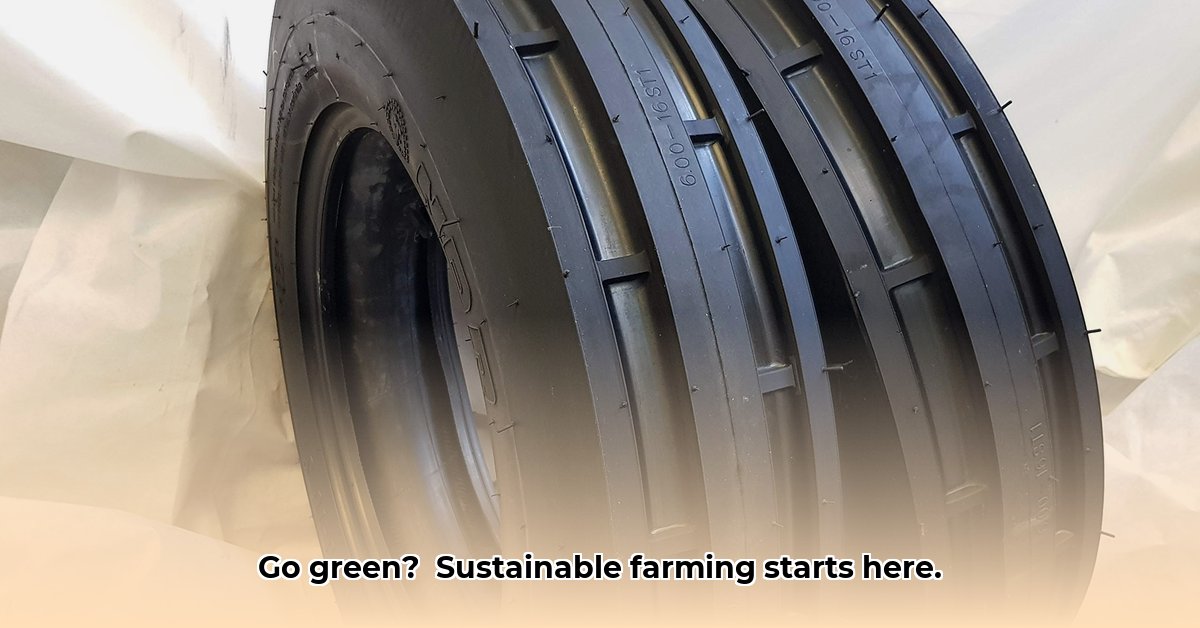
5.50-16 Tractor Tires: A Sustainable Farming Approach
Tractor tires, seemingly mundane components, play a significant role in sustainable agriculture. The ubiquitous 5.50-16 size, in particular, deserves closer examination. Their environmental impact extends far beyond the field, encompassing material sourcing, manufacturing processes, operational efficiency, and end-of-life management. For optimal tire pressure, check out this helpful resource: Tire Pressure Guide. This guide explores how to minimize the environmental footprint associated with these essential components, optimizing both farm productivity and environmental responsibility.
The 5.50-16 Tire's Lifecycle: An Environmental Assessment
Understanding a 5.50-16 tire's lifecycle is crucial for sustainable farming. Each stage—from raw material extraction to final disposal—presents opportunities for improvement. The initial phase involves sourcing rubber, often from rubber trees, a process encompassing harvesting, processing, and transportation, all contributing to the carbon footprint. Steel for reinforcement and various textiles further add to the environmental burden. Manufacturing, a highly energy-intensive process, utilizes significant resources. Finally, transportation to the farm increases the overall carbon footprint. Once in use, improper inflation leads to accelerated wear, increased fuel consumption, and problematic soil compaction. Discarding used tires often results in landfill accumulation, adding to environmental pollution. Isn't it time we considered a more sustainable approach? How much fuel do you waste annually from improper tire inflation alone?
Sustainable Farming Practices: Maximizing Efficiency and Minimizing Impact
Farmers can significantly influence the sustainability of tire use. Several key practices offer substantial environmental and economic benefits:
Tire Lifespan Extension: Regular pressure checks (using a gauge) and adherence to the manufacturer's recommended inflation levels are vital. Underinflation accelerates wear and increases fuel consumption. Regular inspections for damage prevent larger issues later on. Rotating tires also promotes even wear and extends their overall life. Proper maintenance can significantly increase tire longevity by as much as 25%.
Precision Farming: Precision agriculture technologies, such as GPS-guided machinery, enable more efficient movements across fields, reducing overlap and minimizing soil compaction. This results in fuel savings, reduced wear and tear on tires, and better soil health.
Smart Tire Selection: Prioritize tires known for durability and long lifespans. The initial investment might be higher, but the long-term benefits will outweigh the cost through reduced replacements and decreased environmental impact.
Responsible Disposal: Support local tire recycling programs whenever possible. Explore options for retreading or repurposing worn tires for other applications. Responsible disposal minimizes landfill waste and reduces environmental harm.
Manufacturers and Policy Makers: A Collaborative Effort for Sustainability
Tire manufacturers and policymakers play critical roles in promoting sustainable tire production and disposal:
Manufacturers: Should embrace recycled materials (rubber, steel, textiles) in production, minimizing the demand for virgin resources. Investing in the development and production of fully recyclable tires is crucial. Transparent communication regarding the environmental impact through lifecycle analysis (LCA) data empowers informed consumer choices.
Policy Makers: Incentivizing sustainable practices, such as tax breaks for farmers purchasing longer-lasting, eco-friendly tires, can drive market adoption. Investment in robust recycling infrastructure is essential to facilitate proper disposal and material recovery. Implementing stringent environmental standards to regulate tire manufacturing pushes innovation toward greener solutions.
The Future of Sustainable Tires: Innovation for a Greener Agriculture
The agricultural sector's future relies heavily on advancements in tire technology. Research into bio-based materials and the development of fully recyclable tires are promising. Innovative tire designs incorporating sensors to monitor performance and optimize fuel efficiency offer significant potential. However, substantial improvements in tire recycling infrastructure are equally crucial to create a truly closed-loop system, minimizing waste and maximizing resource utilization. What advancements do you anticipate seeing in the next decade?
Soil Compaction: A Key Consideration for Sustainable Farming
Soil compaction significantly diminishes water infiltration and restricts root growth, negatively affecting crop yields and overall soil health. While 5.50-16 tires are essential, their impact must be carefully managed. Utilizing tires with a larger contact area, combined with proper inflation and precision farming, significantly lowers compaction levels. Ongoing research continues to explore the relationship between tire design, soil type, and compaction, paving the way for improved sustainable practices.
Data Gaps and Future Research Needs
Currently, comprehensive comparative studies on the lifecycle impacts of different 5.50-16 tractor tires are lacking. Further research focusing on tire designs, soil interactions, and efficient end-of-life management is essential for promoting truly sustainable agriculture. This research will inform best practices and guide future innovation.
Sustainable Tire Management Checklist: A Practical Guide for Farmers
| Practice | Benefit | Action |
|---|---|---|
| Proper Tire Inflation | Extended lifespan, reduced fuel consumption | Regularly check and adjust tire pressure; use a gauge. |
| Tire Rotation | Even wear, improved lifespan | Rotate tires according to manufacturer's recommendations. |
| Precision Farming Techniques | Reduced soil compaction, fuel efficiency | Utilize GPS technology for precise field operations. |
| Tire Recycling | Minimizes landfill waste | Support local recycling programs; explore repurposing. |
By adopting these sustainable practices, promoting innovation, and fostering collaboration among all stakeholders, we can significantly reduce the environmental impact of farming and move towards a truly sustainable agricultural future.